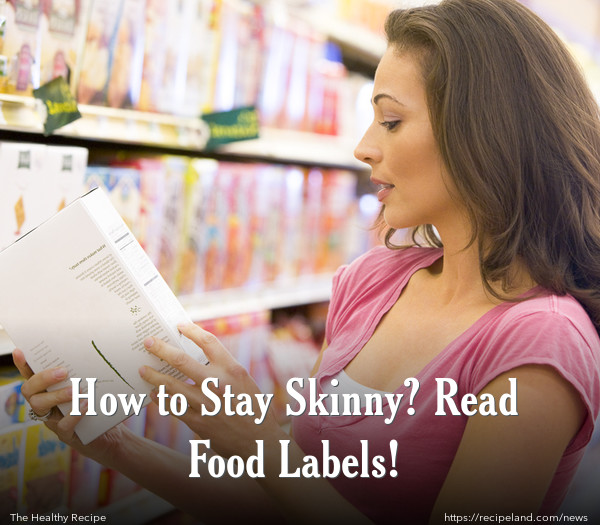When the research clearly shows that people who read food labels stay skinnier and healthier, it should make you want to read them, too. Learn what to look for and what it means to your health.
When you do your grocery shopping, you want to get the best deals and the best foods. But, this doesn’t mean you should just run through the store and grab what looks good or what is on sale this week.
If you want to become or stay healthy, you have to learn how to read nutritional labels. Once you learn how to do it, it is something that takes only a few minutes and it is a huge step toward becoming healthier—controlling what you put into your body is critical.
Recently, the Centers for Disease Control reviewed a study conducted at the University of Santiago de Compostela which discovered that women who make it a habit to read nutritional labels actually weigh less than those who toss the foods into their shopping basket without examining them.
To some, these results seem like they would be obvious, but what is striking is how much of a difference it made in the two groups of women analyzed. The women who read nutritional labels weighed almost nine pounds less and had significantly lower BMIs than the group who were less cautious about the nutritional labels.
In addition, they had a far lower chance of developing breast cancer, cardiovascular disease, diabetes, memory loss and many other chronic health conditions that plague the unhealthy ones.
Learning to read a nutritional label is not difficult. If you have wondered about which parts are most important, and what you should be paying attention to first, then you are in luck because the FDA has recently redesigned nutritional labels, making them far easier for the average person to read and understand.
The new design is intended to reflect current research regarding good nutrition. Some of the changes will include a listing indicating the amount of added sugar in a product, the percentage of whole grains and a very visible calorie display. When you have the facts in your hands, it can be easier to make healthy choices.
The study described above indicated that about 75% of women and just under 60% of men read at least some labels while shopping. The effects of the choices they made with the knowledge gained from reading the labels was more significant for women.
The study also revealed that those living in urban settings were far more likely to review nutritional labels than their rural or even suburban counterparts. High school graduates and college grads were also more likely to read labels compared to the less educated segments of the population.
And, not surprisingly, those who smoked were less likely to review labels than non-smokers.
Although the demographics are fairly predictable in this particular case, even if you do not fall into one of these “label reading” groups naturally, it is something you can easily learn to do and it can have terrific health benefits, whether you are trying to lose weight or just remain healthy.
Start by reading just a few labels next time you are in the grocery store, and slowly work your way up. Once you get used to it, it only takes a few seconds, and it is time well spent as an investment in your good health.
Foods that come without any labels, such as fresh fruits and vegetables, are certainly going to be the healthiest. When foods do have a label, you want to look for ingredient lists that are short. Foods with the least number of ingredients tend to be healthier.
As you learn how to read nutritional labels, here are some of the things that you should be looking for and avoiding whenever possible:
Simple sugars. Any ingredient that has an ending of “-ol” or “-ose” is derived from a type of alcohol that is quickly converted into sugar. This added sugar affects the proteins that you consume by weakening them. This has an aging effect on your joints and arteries, as well as your immune system. Stick to foods with less than 4g of sugar in each serving.
Enriched, bleached or refined flour. Any time flour is enriched, bleached or refined, it has essentially been washed and all of its nutrients have been removed through the processing. When this happens, it becomes simple carbs which are converted into sugar in the bloodstream, very quickly. Instead of reaching for products containing this, choose whole grains. Whole grains take much longer to be converted into sugar and keep you feeling fuller longer because of the fibre included. If whole grain flour is not the first ingredient, steer clear.
Any added syrups, especially high fructose corn syrup, should be avoided whenever possible. This is a synthetic form of sugar that can have an effect on your body’s ability to know when it is full—in essence, keeping you feeling hungry longer. This can lead to significant weight gain and the associated chronic health conditions.
Trans fats. This is an artificially made fat that wreaks havoc on your system, and you should avoid consuming any foods which contain trans fats. Your metabolism will be negatively affected, and you can begin to develop fatty plaque deposits in your arteries, leading to a condition known as atherosclerosis, or hardening of the arteries. Anything that says “partially hydrogenated vegetable oils” should be put right back on the shelf, not into your basket.
This type of fat is not good for you. It can raise the levels of “bad” cholesterol in your body, and also often contains compounds such as carnithing and lecithin, both of which are known to cause inflammation. Keep your intake of saturated fats to less than 4g within an hour if you want your body to process it more effectively.
Choosing healthy foods is actually easy, but you do have to learn a little bit about how to effectively read nutritional labels so that you can make the right choices.
When foods are labeled on the packaging with declarations such as “low fat” or “zero trans fats,” don’t be fooled, these are often loaded up with added sugars instead. Read carefully, your health depends on it!
SOURCES: https://news.yahoo.com/want-stay-skinny-science-says-read-labels-174040328.html;
https://www.heart.org/HEARTORG/GettingHealthy/NutritionCenter/HeartSmart
Shopping/Reading-Food-Nutrition-Labels_UCM_300132_Article.jsp;
Image courtesy of Ambro / FreeDigitalPhotos.net










Comments